
(Photos © J. Maus/BikePortland)
Yesterday the Hawthorne Bridge bike counter logged its 2 millionth trip since it began tallying riders on August 8th, 2012.
That puts the average weekday amount of bicycle trips over the bridge (in both directions) at about 5,600. For comparison, there’s an estimated 22,000 cars crossing the bridge on an average weekday — which means bicycle traffic accounts for about 20% of the bridge’s total vehicle traffic.
Thanks to the web interface that keeps a running tally of the data collected by the counter, we can dive into trip statistics on a daily, weekly, and monthly basis. So far, the highest recorded day was June 8th of this year with 9,834 bicycle trips (that date also happened to be the World Naked Bike Ride). When you look at weekly and daily totals, it becomes very clear that weather plays a major factor in how many people bike each day. PBOT hasn’t crunched recent numbers alongside weather patterns yet, but my cursory analysis shows a drop-off of about 2,000 daily trips when the weather turns iffy (we hope to share more data on the weather correlation in a separate post).
Here’s how the monthly trend looks since last August…
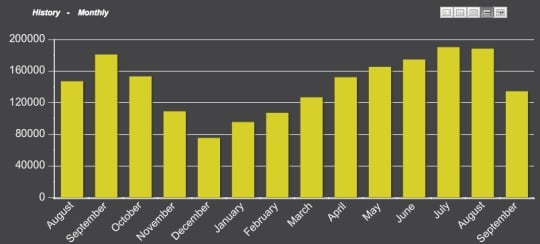
These numbers validate what we’ve known for years: The Hawthorne Bridge is a key artery in our road network and Portland is much better off because so many of the vehicles it carries happen to be bicycles. As we shared back in 2010, since 1991 Portland has increased the amount of people who travel to and from the central city via the Hawthorne Bridge by 20%; and because that increase in total vehicle traffic has been almost entirely bicycles, we have reaped major benefits. If the motor vehicle trips had increased at the same rate, we would have widespread congestion, more toxic pollution in our air, and we would have a more urgent need to make costly investments into the bridge and adjacent roads and ramps.
To commemorate the 2 millionth bike trip and soak in this span’s cycling splendor, I hung out on the bridge yesterday afternoon in hopes of spotting rider number 2 million…
— Read more stories about the Hawthorne Bridge bicycle counter in our archives.

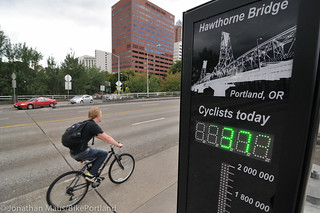
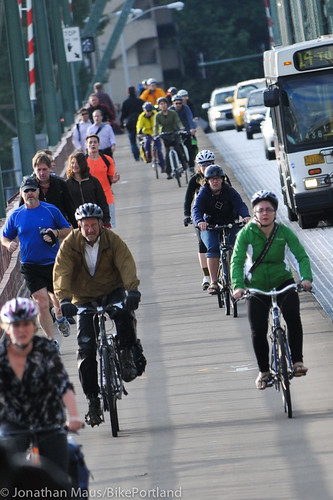
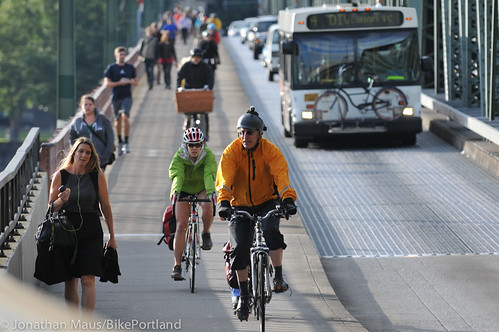
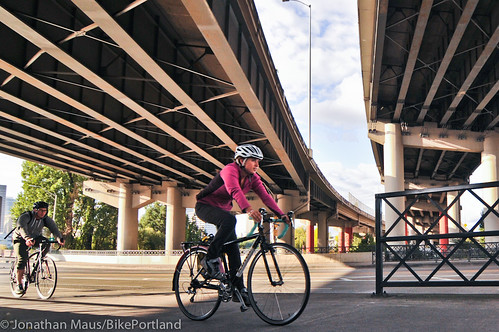
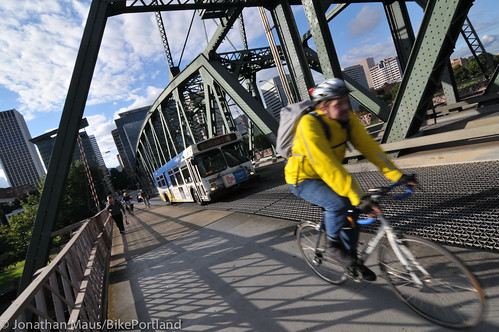
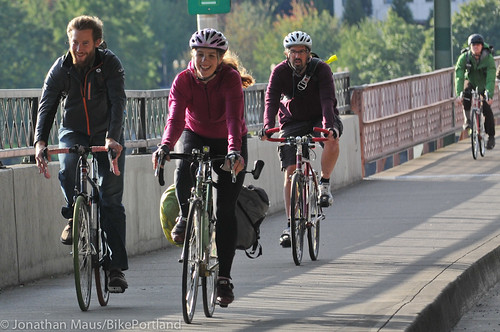
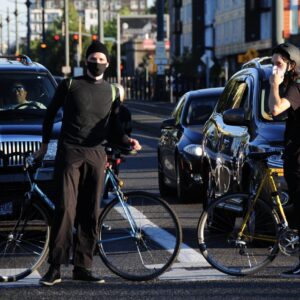
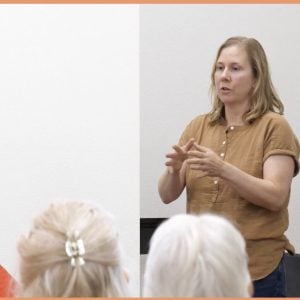
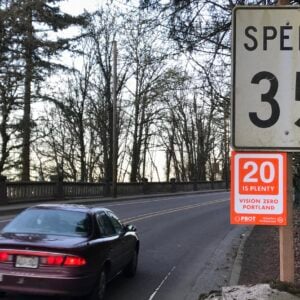

Thanks for reading.
BikePortland has served this community with independent community journalism since 2005. We rely on subscriptions from readers like you to survive. Your financial support is vital in keeping this valuable resource alive and well.
Please subscribe today to strengthen and expand our work.
Proud to have contributed a several hundred rounds.
I’m surprised to see such a big difference between December, January, and February – the 3 months are approximately equally cold and wet, though I guess December is darkest.
I bet part of the drop in December is due to PSU students home on winter break and us regular working Joe’s taking some family time during the holidays.
Yes, I agree. A few holiday’s on weekdays can skew those numbers a bit.
..and also in December there are a lot of vacations and more importantly office/ family parties that might keep the winter diehard riders off of their bikes too.
While this website is obviously going to focus on people on bikes, let’s not forget those on foot. That’s probably another few thousand trips per day that otherwise could have been cars. Good thing we’re still spending just a tiny fraction of our transportation dollars on Active Transpo, eh?
In a couple of these photos, there are as many people on foot as on bike. It would definitely be worth taking them in account too, in figuring impact on downtown traffic. A lot of people I know who walk across the Hawthorne, however, do so from the close-in Eastside, where they’ve parked after driving in from the suburbs. Still a plus for individual health, downtown air quality/congestion, and wear and tear to the bridge. It would be interesting to find out more about this effect.
yes! I agree with everyone who has mentioned the number of people who walk on this bridge. I’m not aware of any counts but it would be great to know the human-powered mode share on this bridge.
Do we have machines that count pedestrians reliably or would the city be better off paying the panhandlers that are consistently there to do the counts?
This is one thing the BTA should really get credit for – pushing the City and the County to widen the Hawthorne Bridge sidewalks.
I always love when you take pictures of people on bikes, and I love following the Hawthorne bridge counter.
What I see when I look at pictures of people on bikes is sporty, hip folks in the 20-50 range, which Portland has a lot of (and I fall into), compared to the rest of the country. The question is, can the city with the most bikers continue to grow # of bikers, or have they maxed out that demographic of daring cyclists?
The Hawthorne bridge counter, with your pictures, will tell over time, which is why it is such a cool thing.
Wishing for a bike counter in Nashville,
Edwin
Not to be overly picky, but I would recommend removing one use of “over” from the headline for this story. I think “logs 2 million trips” gets the job done.
The year over year data is starting make these numbers more interesting, but I’m also curious to see count data from the the other bridges. I’ve switch my commute to the Burnside almost exclusively to avoid the congestion on the Hawthorne. I wonder if others are doing the same.
Thanks for the headline feedback Ian. I agree. I changed it. And interesting thought about people changing behavior due to congestion.
If you want low congestion, the separated path on the Morrison bridge is even better…
Especially if you are heading into NW, it hooks right up to the light rail couplet and Stark, so you can get to 20th and NW very quickly with little traffic compared to other routes. Hopefully, this can be made bike-only with the $6.6 Million DT will be getting. Combined with some east improvements this could become a nice route.
Bike congestion is real. I switch over from Clinton to Salmon at 34th on my way into work, to avoid bike congestion through Ladd (I don’t cross the river).
The Hawthorne isn’t on my usual commute, but I dislike riding it because it’s congested and feels scary. Williams *could* be part of my regular commute, but I avoid it because it’s congested and feels unfriendly. Riding in crowds of other bike-riders takes all the fun out of it for me.
It’s nit picky, but 5600/22000 = 25%, so fully a quarter of the traffic on the bridge is bicycle traffic, unless as mentioned above, someone actually counted pedestrians, in which case the percentage would be different.
Wouldn’t it be 5600 bikes / (22000 cars + 5600 bikes)? That would mean bikes are about 20% of bike + car traffic, which was the original number.
Yup. I was just realizing this and went back to check and see if anyone caught my error. Mea Culpa.
I wonder if the % of bridge space allocated to bike/ped traffic is more or less than that traffic’s percent of people crossing the bridge. I’m guessing bike/ped is getting less space than its fair share by that metric but maybe the buses would push up the # of people in the motor vehicle lanes. Anybody have data on that?
I can’t help but to notice that the calculations going on here may be a bit skewed (assuming the numbers are reported accurately):
5,600 bikes
22,000 cars
————————————–
Total # of Bikes & Cars = 27,600
# of Bikes / Total # of Bikes & Cars –> 5,600 / 27,600 = 20.3% Bikes
…or…said in a different way, there is approximately 25.5% the number of bikes compared to the number of cars.
This is of course only comparing the # of people biking vs. the # of cars (as it has been mentioned multiple times in the comments above that the number of people walking would also be nice to know but we don’t have a good estimate of those numbers – in addition to the number of people in the buses during the bridge crossing as well as the # of people IN the cars, but I digress…)
Ooops….when typing my post, someone already did the same….my apologies.
When I see telephoto shots of Hawthorne Bridge traffic, I still see flashbacks of Tommy Lee Jones running from the bad guys in that movie…
Do we have corresponding automotive counts over time to show if an increase in bike traffic corresponds with a decrease in automobile traffic on Hawthorne Bridge?
Over several years we could show a mode shift trend change; seasonally we can show how many fair weather cyclists are going directly to automobiles or are using other transit modes.
I know I’ve seen these numbers somewhere…. To paraphrase my memory, I think car traffic has remained steady (since like the 90s??) while bike traffic and regional population has increased.
As linked to in the story… here is what PBOT bike coordinator Roger Geller says
Below are two slides from Geller’s presentation that tell this story. Each one is followed by his slide notes (emphasis mine):
But….
We need to compare and contrast this 1% automotive traffic growth over 17 years on Hawthorne Bridge to the other downtown bridges in the framework of all total Willamette River crossing traffic.
Also, I’d be curious to see if the seasonal decline in bike traffic corresponds with an increase in automotive traffic as these people riding bikes are still commuting but choosing not to get wet/cold. Initially I’d say a lot more cars but if they are driving the energy penalty for less efficient routing may not contain fair-weather bike traffic turned drivers only to Hawthorne; similarly TriMet riders go wherever the route goes. Maybe there is also a seasonal reflection of decreased bike use in increased TriMet ridership.
Johnny Five needs more input!
…and potentially remove the bridge or add a new MV bridge crossing….for more cross river MV capacity
So apparently my memory is awesome, but my ability to find useful links in articles isn’t!! Thanks Jonathan.
It will be interesting to see what happens when the new bridge comes on line. Will it siphon off from the Hawthorne a good portion of the bike traffic? Decrease car traffic on the Hawthorne b/c of light rail?
All speculation here
I bet the new bridge takes half or more of the Hawthorn riders away. And that it will surpass Hawthorn in numbers. Most the current commuters from South of SE Lincoln will probably use the new bridge. That only really leaves the people North or Lincoln to about Stark that would use the Hawthorn as the most direct route.
Then toss in the fact that those neighborhoods south of Powell (Brooklyn and the Morelands) will also have much better access when the Max line bridge is done. And the fact that even people commuting on the Springwater will also most likely use the new bridge
I’m just wondering what the bridge will be named. I vote for “the Spokes”
Just my two cents.
It will depend on how good the connections between the east end of the new bridge and the local street grid are. If it ends up being a nightmare of traffic congestion or rail crossings, for example, less people will use it.
That’s a lot of people on bikes. I know a lot of them are not “Cat 6 racers” trying to get to the other side as quickly as they possibly can. There are also a lot of people walking across the bridge, although the counter doesn’t record them.
Maybe some of the people who are riding bikes should consider this and slow down a bit rather than buzzing, yelling at or passing on the right of others who are using this as a transportation route and not a time trial stage.
Doesn’t help that the bridge is set up for using the pedestrian lane as a passing lane. It’s a bad design based around the flawed assumption that bicycles work more like pedestrians than vehicles.
So can we please, get a second bike lane in each direction, and a separate sidewalk for pedestrian use? Portland’s dangerous over-reliance on “mixed use paths” is fundamentally flawed given the traffic volume on most routes now, as compared to a dedicated cycleway with pedestrian sidewalks.
The new bridge not only will relieve congestion on the Hawthorn but it also will increase overall numbers as long as both the east and west end connections are improved.
The next big issue will be congestion coming from North and NE Portland. The lower deck of the Steel is already over capacity and the Broadway is a dangerous bottleneck.
So, should we be talking about eliminating all top level auto traffic on the outer lanes on the Steel and dedicating an entire lane in each direction to bikes?
As part of Portland’s plan to reach 25% bike mode split…how have the City’s internal discussions gone with the Bridge’s owner (County) about when the outside MV lane would be changed to a Bike Path?
[Perhaps it is time for the City to offer to buy the Hawthorne bridge from the County.]
The Hawthorn Bridge is over capacity in the peak hour if you were to look at the potential conflicts between peds and bike traffic. Not sure more growth can be had on the bridge during the peak without other less ideal changes…such as removing peds (not suggesting it). Bike volume growth outside the peak period can still be accommodated.
Many of the readers on BikePortland were not around before the early Portland Bridges were made bike accessible…these were the BIG improvements done in the 90s…I remember the national press writing about it…
…and thank you Mia, Earl, Rex, etc. This foundation made the mid 2000’s bike growth onto the arterial bikeways possible.